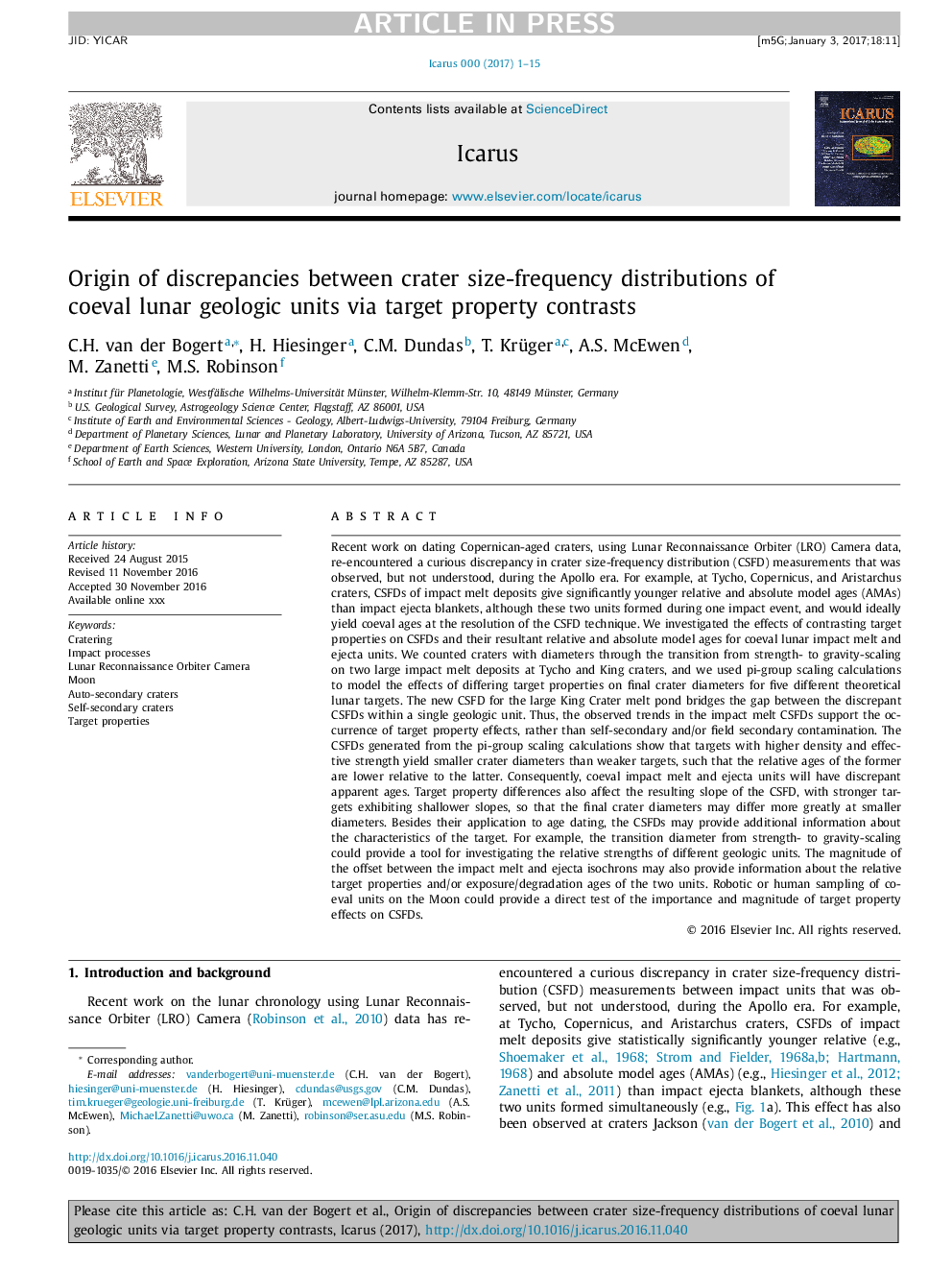| کد مقاله | کد نشریه | سال انتشار | مقاله انگلیسی | نسخه تمام متن |
|---|---|---|---|---|
| 5487340 | 1523493 | 2017 | 15 صفحه PDF | دانلود رایگان |
عنوان انگلیسی مقاله ISI
Origin of discrepancies between crater size-frequency distributions of coeval lunar geologic units via target property contrasts
ترجمه فارسی عنوان
منشا اختلافات بین توزیع فراوانی اندازه دهانه از واحدهای زمین شناسی ماهانه از طریق تطابق اموال هدف
دانلود مقاله + سفارش ترجمه
دانلود مقاله ISI انگلیسی
رایگان برای ایرانیان
موضوعات مرتبط
مهندسی و علوم پایه
علوم زمین و سیارات
علوم فضا و نجوم
چکیده انگلیسی
Recent work on dating Copernican-aged craters, using Lunar Reconnaissance Orbiter (LRO) Camera data, re-encountered a curious discrepancy in crater size-frequency distribution (CSFD) measurements that was observed, but not understood, during the Apollo era. For example, at Tycho, Copernicus, and Aristarchus craters, CSFDs of impact melt deposits give significantly younger relative and absolute model ages (AMAs) than impact ejecta blankets, although these two units formed during one impact event, and would ideally yield coeval ages at the resolution of the CSFD technique. We investigated the effects of contrasting target properties on CSFDs and their resultant relative and absolute model ages for coeval lunar impact melt and ejecta units. We counted craters with diameters through the transition from strength- to gravity-scaling on two large impact melt deposits at Tycho and King craters, and we used pi-group scaling calculations to model the effects of differing target properties on final crater diameters for five different theoretical lunar targets. The new CSFD for the large King Crater melt pond bridges the gap between the discrepant CSFDs within a single geologic unit. Thus, the observed trends in the impact melt CSFDs support the occurrence of target property effects, rather than self-secondary and/or field secondary contamination. The CSFDs generated from the pi-group scaling calculations show that targets with higher density and effective strength yield smaller crater diameters than weaker targets, such that the relative ages of the former are lower relative to the latter. Consequently, coeval impact melt and ejecta units will have discrepant apparent ages. Target property differences also affect the resulting slope of the CSFD, with stronger targets exhibiting shallower slopes, so that the final crater diameters may differ more greatly at smaller diameters. Besides their application to age dating, the CSFDs may provide additional information about the characteristics of the target. For example, the transition diameter from strength- to gravity-scaling could provide a tool for investigating the relative strengths of different geologic units. The magnitude of the offset between the impact melt and ejecta isochrons may also provide information about the relative target properties and/or exposure/degradation ages of the two units. Robotic or human sampling of coeval units on the Moon could provide a direct test of the importance and magnitude of target property effects on CSFDs.
ناشر
Database: Elsevier - ScienceDirect (ساینس دایرکت)
Journal: Icarus - Volume 298, December 2017, Pages 49-63
Journal: Icarus - Volume 298, December 2017, Pages 49-63
نویسندگان
C.H. van der Bogert, H. Hiesinger, C.M. Dundas, T. Krüger, A.S. McEwen, M. Zanetti, M.S. Robinson,
